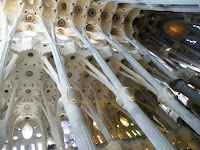Its hard to imagine any outdoor space remaining "organic" after an architect gets his hands on it. For sure, there are plenty of locations that are stunning, from the Taj Mahal up to Niemeyer's International Cultural Centre in Aviles, Spain. But Antoni Gaudi is not in that mould,
 |
| Dragon Steps |
The Park Guëll - originally conceived as an estate for well-off families - is a fair step from Las Ramblas. Taking the metro is obviously the easiest way - with our free pass - but even then it was a robust 15 minute hill-walk through rather anonymous streets. Directions are well signposted and eventually we wandered into the backstreets where houses take on a more interesting appearance. This is or was a more affluent part of the city and classically inspired balustrades and facades are built into the hillside claiming every inch of expensive real-estate. A great improvement on modern angular concrete streets but even this cannot prepare you for what is to come.
The park is not easy to access so either buy a ticket before-hand or allow time for queuing, depending on season. And remember the park can close early especially in the off-season. I am not sure how we navigated there but it wasn't a traditional approach and we ended up at one of the side-entrances. This meant we had little clue of what we were about to see; which was probably a good thing.
 |
| Gaudi's Salamander |
Instead we dandered along pathways threading their way through formal gardens with occasional slopes supported by the most extraordinary colonnades. Now and again we caught glimpses of mosaic tile work on park walls or verdigris roofs above the tree-line. All very pleasant especially in the warmth of the day. Not many people about either. Then we arrived at the main entrance and were flabbergasted.
On one side is the fabulous Dragon Stairway clothed in white mosaic tile and featuring what has become an iconic emblem for Barcelona, Gaudi's salamander though in my ignorance I still think of it as a gecko. At the foot of the stairs is a grotto supported by a singular inverted conical pillar but the steps lead up to a huge area of fluted columns supporting a moulded ceiling encrusted with mosaic. This seems just a bit of an extravagance till you realise this is the support for the huge open space plaza above.
 |
| Porter's Lodge |
In the other direction, looking down the stairwell now towards the sea shimmering in the distant haze, is the most extraordinary confection; mere mortals could not conjure up such fabulous structures never mind the ornamentation and decoration. These are the pair of porter's lodges on either side of the main entrance to the park. Make sure you have plenty of space in your camera to take loads of pictures, every detail of these buildings is extraordinary, hardly a straight-line in sight from the scalloped gable, the tapering chimney, to the swollen or recessed windows, everything a sensual delight.
I've no idea what was inside the buildings, the queues were too long. Hopefully it was the toilets or the ticket office or something else equally banal because we never got in to see. Instead we wandered up a tree lined avenue to sit and recover from the sensory overload - and have a bite of lunch. Even something as ordinary as a baguette with cheese, tomato & ham acquired an exotic appeal in these surroundings. Admittedly this was a wonderfully soft, warm day in the middle of November surrounded, it seemed, by people from every nation of the world, fortunately not too many of them as it was autumn.
 |
| Gaudi's seat |
Eventually we stepped out again, following the paths through the park to arrive at the Gaudi House Museum that was Gaudi's home for many years. As a museum now, it houses many examples of his furniture and other artefacts. The building itself is filled with wonderful art nouveau excesses, toned down perhaps without Gaudi's flourishes but this just helps to accentuate his imagination displayed in some of the display pieces:
- the unbelievable 5-seater armchair set appropriately enough on a pedestal
- the twisted and folded honeycomb-like gilded metal-work that would have been at home on a Geiger set
- the phenomenal bench seat from the crypt de la Colónia Guëll that seems to have been grown rather than constructed
- the amazing coloured-glass lantern hanging from the ceiling in one of the rooms
- the baby's cradle where you need to read the explanation to figure out what it is
And so it goes on - the decoration of the ceilings, the tactile banisters on the stairs and even the outside decoration around the windows. As the song goes, these are only a few of my favourite things to be found here - plenty more for you to discover.
And we are not done yet.
 |
| Wall of Grand Plaza |
Wandering through the gardens again we discovered plenty of sculpture both small and large. and of course the structural viaducts, walkways, flights of steps all enhance the tall fir trees and shrubs. Eventually all paths lead you to the grand plaza. It extends out from the hillside supported by the columns below to create a huge flat space bounded by a single, meandering bench seat encrusted with colourful mosaics. You can sit here and stroke it, peer down at the entrance lodges and steps, gaze out to sea or simply people watch at the crowds of smiling faces. It must be impossible to visit here and not be enlivened by this place: smiling, glittering eyes and a contented sigh.
The only downside was at closing time when we had to leave the birds of paradise calling in the trees (parakeets actually).

























